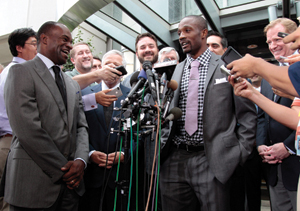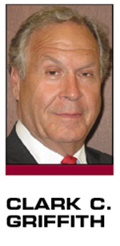Editor's note: This story is revised from the print edition.
Just a year ago, the sports world faced a colossal battle. Three leagues’ labor contracts were expiring and severe disruption was almost certain to occur. Today, all three leagues have long-term labor agreements, but because of one court’s decision, the way sports labor wars have been waged for 40 years has changed.
The NFL’s collective-bargaining agreement was the first to expire. The impasse resulted in a settlement and a significant decision by the 8th U.S. Circuit Court of Appeals involving antitrust.
Antitrust has been involved in sports labor negotiations since Mackey v. NFL in 1975, when the players union used antitrust to attack the Rozelle Rule that limited free agent movement. The union succeeded, and antitrust has been part of sports union strategy since.
The sports industry is unique in that teams cannot individually produce the product that is sold by them collectively. The creation of a game requires a large degree of cooperation among teams perceived as competitors. This cooperation is the basis for antitrust claims by players who use the Sherman Act to attack the teams’ efforts to collaborate as a league. The Sherman Act’s Section 1 prohibits competitors from acting together in restraint of trade. Therefore, if league members act together to restrain player compensation, they violate the act. If found guilty, they pay three times the damages and attorneys’ fees as well.
If the players are unionized, however, there are two antitrust exemptions that bar such claims. These are the statutory exemption from the Clayton Act and the non-statutory exemption from case law. In essence, these exemptions say that if a matter originates in labor law, no antitrust claim can be filed.
 |
NFL players and league and union leaders reached an agreement after a 132-day lockout.
Photo by: GETTY IMAGES
|
The prevailing thought has been that if a union decertifies its union status or its leadership disclaims its interest in representing the members, the exemptions cease to apply, and antitrust claims can be filed. This has been the course of action since Mackey and Powell v. NFL in 1989.
Since then, a series of cases has determined that the antitrust exemptions continue past any impasse in negotiations or until the union ceases to exist. From Powell on, the scenario has been the same: The labor agreement expires, the union decertifies, then, as an association, files or threatens an antitrust claim. The parties then reach a settlement, and the union is on again, re-establishing the antitrust exemptions mentioned before.
This is what happened in the Brady v. NFL case in 2011. The NFLPA disclaimed four hours before the agreement expired, and the league instituted a lockout — a labor action — just after the agreement expired on March 12. The union then filed an action to enjoin the lockout in federal court in Minnesota.
As expected, the federal court enjoined the lockout, denied a stay pending appeal, and the game was on. The NFL appealed to the 8th Circuit in St. Louis. A three-member panel of the appeals court stayed the Minnesota court’s injunction until it could rule on the legality of the lockout. Its ruling, issued in early July, changed the playing field as it reversed the Minnesota court and found that the Norris-La Guardia Act barred the injunction. By this time, the NFL and the players union had begun negotiations again and arrived at an agreement in late July.
Applying the law
The issue before the two courts was whether the Norris-La Guardia Act applied. This act says that courts cannot enjoin actions that arise from labor matters. The 8th Circuit ruling that ended the district court’s injunction changes the labor/antitrust confrontation that has been present in sports for 40 years. The ruling goes so far in protecting management’s labor law rights that it may have eliminated the antitrust action that has been so typical and destructive of sports labor relations. It does so by applying a more complete analysis of the National Labor Relations Act and, importantly, the Norris-La Guardia Act to protect labor law actions by leagues where these actions “grow out of a labor matter.”
Section 7 of the National Labor Relations Act gives employees the right to form unions and “to engage in other concerted activities for the purpose of collective bargaining or other mutual aid or protection.” In other words, the players are covered under the labor acts as long as they are involved in concerted activities, whether they are a union or an association.
The 8th Circuit never got to the issue of the nonstatutory exemption’s application, but it seems that the same process that applied the Norris-La Guardia Act to injunctions will apply to the nonstatutory exemption, as well.
The district court in Brady defined a labor dispute as one involving an employer and a union. The 8th Circuit went much further by recognizing that the Norris-La Guardia Act applies to concerted activity and said, “We see no warrant to add a requirement of unionization to the text [of the NLGA].” Concerted activity is what is protected under labor law, not union activity. It is where two or more employees take action affecting working conditions, as shown in Washington Aluminum, a pivotal labor law case cited by the 8th Circuit majority.
What this means going forward is that sports labor disputes will be decided by traditional labor means, as in MLB. The National Basketball Players Association conducted a pure labor negotiation in 2011 and survived an NBA lockout. The league has completed a shortened, but successful, regular season.
This summer, the NHL and the NHL Players’ Association will be negotiating a contract along pure labor lines.
The 8th Circuit in Brady has expanded the coverage of the labor laws, muted the use of antitrust, and created an environment contemplated by the drafters of the Norris-La Guardia Act and NLRA, where both sides are equal and the issue is decided at the bargaining table and not a federal courtroom.n
Clark C. Griffith (ccgpa@ccgpa.com), an attorney and arbitrator in Minneapolis, is a former owner, treasurer and executive vice president of the Minnesota Twins. He was chairman of Major League Baseball Properties and a member of the MLB labor negotiating committee. Follow him on Twitter @ccgpa.





